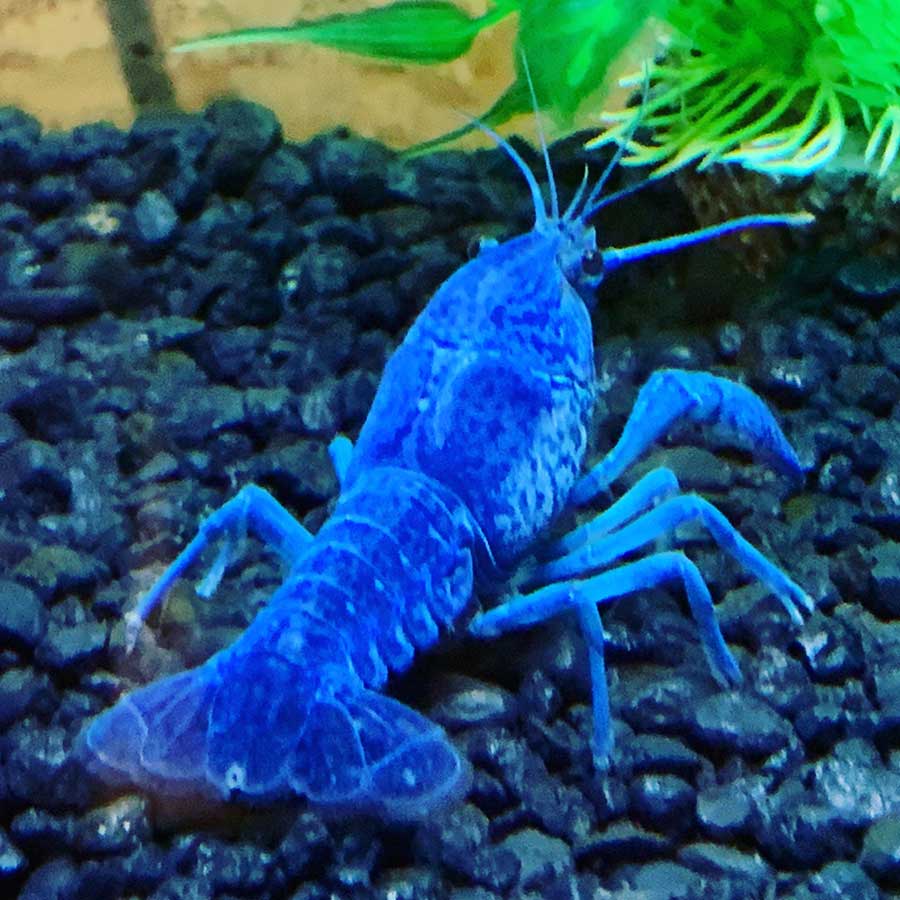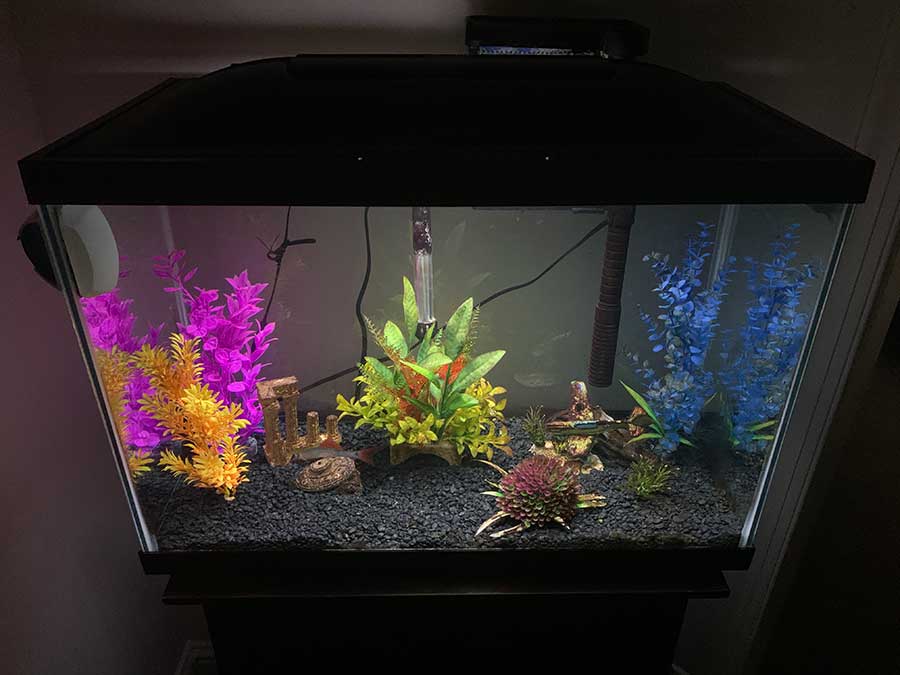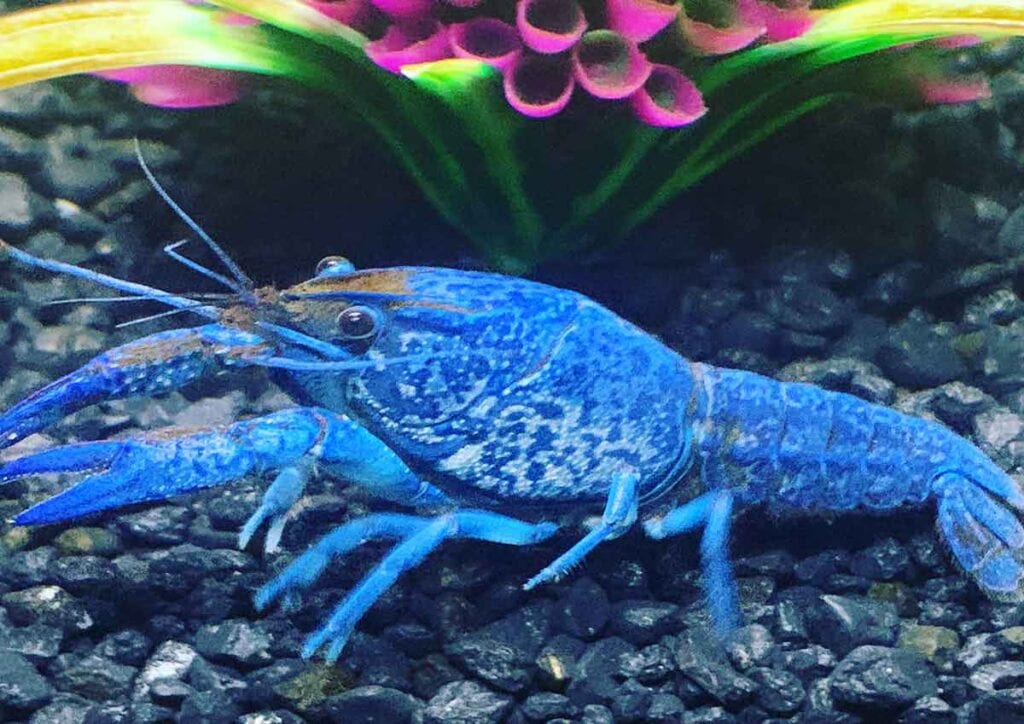In this blog, I’m going to talk about fish tank sizes for blue lobsters. I’m going to give you my opinion based on my experience with keeping blue lobsters and other pet crayfish as to what I think is the ideal fish tank size for these amazing creatures.
Blue Lobsters: Roaming, Burrowing & Eating
Certain characteristics of blue lobsters should be kept in mind when considering the perfect fish tank size for a crayfish. Blue crays like to roam about the aquarium, burrow in their hideouts, and eat. Actually, they like to eat a lot.
Crayfish are omnivores and they’ll eat pretty much everything they can. This means they’ll eat your other fish if they can. So always consider keeping fast swimmers, semi-aggressive fish, and fish that swim near the top of the tank like hatchet fish.
Blue crays are scavengers. And, they are very hardy and can live in pretty rough water conditions.

Roaming
Because crayfish like to roam about when not burrowing, you should have a tank that is not so small they can’t move about. For this reason, I always suggest at least a 20-gallon fish tank. This is especially a good choice if you plan on keeping other freshwater fish in the same tank with your cray.
A tank size of 20 gallons or more allows both a crayfish and a few other fish to have space. However, keep in mind, as alluded to above, you can only keep certain fish, or tankmates, with your pet crayfish. That’s because, as many know, crays will again, eat other fish in the tank if given the opportunity. I’ve had to learn this the hard way.
Burrowing & Hideouts
Crayfish are also known for burrowing under or in a hideout. You can buy hideouts online or make them out of PVC pipe.
Since crayfish shed their exoskeletons, a process known as molting, hideouts come in very handy. They allow crayfish to hide from other aquatic life while their new exoskeleton grows back and strengthens.
Eating
Crayfish eat a lot. They love to eat pretty much anything and are not picky eaters. Because of this, they put out a lot of waste into the tank. They are very dirty animals. And if a fish tank is not big enough, it can get dirty really fast. This means more water changes and can even put other fish at risk. So, if keepers of blue lobsters have tanks that are too small, issues can arise, obviously.
Caring For Blue Lobsters’ Fish Tanks

One of the most important parts of taking care of your blue lobster and other aquatic life is cleaning your fish tank. Cleaning a fish tank regularly and correctly is necessary for keeping your tank clean and keeping all of the life in it healthy.
Since crayfish are pretty dirty, cleaning times can vary. I try to stay on top of cleaning my fish tank—cleaning it before there is algae overgrowth or cloudy water. To do this, I change roughly 15 to 20% of the water every one to two weeks. This can definitely help reduce the headache that comes with a tank that gets slimed with algae and other gunk.
Cleaning a fish tank:
- Reduces algae overgrowth
- Removes toxins
- Maintains a healthy environment for your blue lobster and other fish
Fish Tank Recommendations for Blue Lobsters
I’ve written several detailed blogs on which 20-gallon fish tanks are best. In short, however, I’d suggest a fish tank kit if you are starting out. That’s because they are affordable and come with literally everything you need to get started. These kits will give you a good idea of the aquarist hobby and if it’s something you want to pursue. And, a 20-gallon aquarium will fit nicely in a home or office.
Fish tank kits usually include the following:
- A water pump
- Thermometer
- Fishnet
- Food
- Water conditioner
- A fish tank cleaning pad
Recap on Blue Lobsters and Fish Tank Size
In this blog, we took a look at the characteristics of blue lobsters that have an impact on the ideal fish tank size for them.
Crayfish like to roam, burrow, and eat. They also put out a lot of waste. For these reasons, it’s necessary to have a tank that is big enough so that it doesn’t get dirty too quickly and so that your crays can roam, burrow, and hideout as needed. Also, a tank such as a 20-gallon tank provides room for other fish to live with your cray, and hopefully not get eaten.

